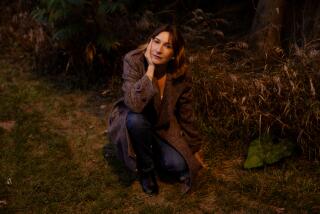Penelope Lively turns inward in ‘Dancing Fish and Ammonites’
Admirers of Penelope Lively’s many fine novels will find the same lucid intelligence at work in her elegantly written “view from old age,” which she dubs “not quite a memoir.” The British writer, who turned 80 in 2013, meditates on several subjects that have preoccupied her fiction (memory, history, social change) and some more suitable to nonfiction: books that have shaped her life, a few particulars of that life, and six objects — including the eponymous dancing fish and ammonites — that reveal something important about their owner.
Lively warns her readers not to expect “internal coherence,” the sense that “it could have gone no other way,” which she defines as the essence of a successful novel. Those are the satisfactions provided by art; here, she takes a more casual, informal approach intended to capture “life as lived…. disordered, undirected and at the mercy of contingent event.”
The least successful portions of “Dancing Fish and Ammonites” adhere most closely to this intent. A 12-page montage of random moments from her life, offered as an illustration of how memory works, seems slapdash; so do some of her remarks on the six objects, which ramble in ways that are not necessarily illuminating. But even these slightly disappointing passages contain examples of Lively’s gift for sharply turned phrases and cogent reflection. Considering her ammonites, tiny fossils many millions of years old, she muses, “Deep time. It puts you in your place — a mere flicker of life in the scheme of things.”
In the best chapters here, those sorts of arresting insights flow naturally within a narrative that, if not as carefully structured as Lively’s novels, nonetheless forms a reasonably cohesive whole. “Old Age,” her funny, smart and poignant opening salvo, smoothly situates her personal experiences within the context of affluent Western societies where the elderly are becoming an increasingly large percentage of the population, “gobbling up benefits and giving grief to government agencies,” she notes with characteristic dry humor. She is equally wry about her response to the inevitable physical infirmities — “However did I get like this? What happened?” — and notes that as the energies and ambitions of youth have diminished, she experiences in recompense “an almost luxurious appreciation of the world … I am as alive to [it] as I have ever been.”
A moving discussion of friendships that have endured for decades leads naturally to Lively’s next chapter. “We are each of us an accretion of all that we have been,” she writes, and in “Life and Times” she spotlights the landmarks in her personal history: childhood in Cairo during World War II; relocation to England after her parents’ divorce in 1945; her political awakening during the Suez crisis of 1956; and the ongoing impact of the Cold War and the nuclear arms race on a young mother who “looked at my small children … and thought there was a real chance they would never grow up.”
Her marriage to Jack Lively, “a young man from the northern working class” she met at Oxford, illustrates the vast social changes that have transformed Britain in her lifetime. Lively also considers the wider options available to women (she credits the pill) and the “seismic” change in attitudes toward homosexuality.
A chapter on “Memory” offers some of Lively’s most piercing thoughts about the “unstoppable conveyor belt” of time, which seems to speed up as we age and makes our memories even more important. The delightful “Reading and Writing” section will strike a chord with anyone who, like Lively, “can measure out my life in books,” and it provides intriguing peeks into the genesis of her own fiction. It’s no accident that her three favorite novels are Henry James’ “What Maisie Knew,” William Golding’s “The Inheritors,” and Ford Madox Ford’s “The Good Soldier”; all three are masterpieces of narration that question the accuracy of human perceptions and the truthfulness of the stories we tell, just as Lively has done in such novels as her Booker Prize-winning “Moon Tiger.”
She closes the book with “Six Things,” the aforementioned collection of objects. From a piece of American folk art to a shard of Egyptian pottery a thousand years old, each one reflects her ongoing fascination with physical fragments of the past and with human beings’ efforts to connect with it. Memory, history, archaeology, paleontology — for Penelope Lively, they are all part of our individual and collective effort to retrieve lost time. She chronicles her personal engagement in that quest with wit and rue.
Smith is the author of “Real Life Drama: The Group Theatre and America, 1931-1940.”
Dancing Fish and Ammonites
A Memoir
Penelope Lively
Viking: 234 pp., $26.95
More to Read
Sign up for our Book Club newsletter
Get the latest news, events and more from the Los Angeles Times Book Club, and help us get L.A. reading and talking.
You may occasionally receive promotional content from the Los Angeles Times.






